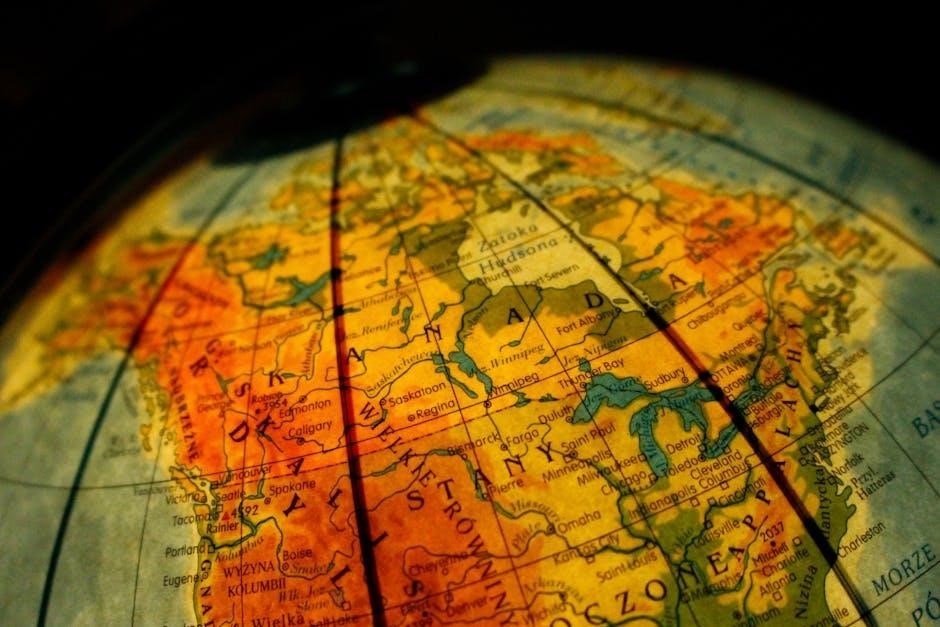A History of the World in 6 Glasses explores how six beverages—beer, wine, spirits, coffee, tea, and cola—shaped human civilization, from ancient times to modern globalization․
Overview of “A History of the World in 6 Glasses”
Tom Standage’s A History of the World in 6 Glasses offers a unique perspective on global history by tracing the impact of six beverages: beer, wine, spirits, coffee, tea, and cola․ Each drink represents a distinct era, from ancient civilizations to modern globalization․ The book highlights how these beverages influenced technological advancements, cultural shifts, and economic systems․ By examining their roles, Standage reveals how everyday drinks have shaped human societies, fostering innovation, trade, and cultural exchange across centuries․
The Concept of Beverages as a Lens for Understanding History
Using beverages as a lens, the book reveals how drinks have driven human progress and cultural evolution․ From beer in Mesopotamia to cola in modern times, each drink reflects the ingenuity, values, and challenges of its era․ By examining their origins and spread, the narrative connects beverages to technological advancements, trade networks, and social transformations․ This approach offers a fresh perspective on history, illustrating how everyday substances have played pivotal roles in shaping civilizations and fostering global connections across centuries․

Glass 1: Beer ⎯ The Dawn of Civilization
Beer, originating in Mesopotamia, played a crucial role in the rise of early civilizations, fostering settled communities and serving as a social and ritual cornerstone․
The Origins of Beer in Mesopotamia
Beer emerged in Mesopotamia around 4000 B․C․E․, likely discovered accidentally during grain storage․ Its production became vital in the Fertile Crescent, where barley and emmer wheat thrived․ Early evidence of brewing comes from ancient Sumerian tablets, showcasing beer as a staple in daily life and religious rituals․ The drink facilitated the transition from nomadic to settled communities, enabling the rise of cities and civilizations․ Its significance extended beyond nutrition, fostering social bonds, trade, and cultural practices that laid the groundwork for urbanization and technological advancement․
Beer and the Rise of Settlements in Ancient Egypt
Beer played a central role in ancient Egypt, serving as both a nutritional staple and a form of currency․ Its production and distribution facilitated the growth of settled communities along the Nile․ Egyptian laborers, including those constructing the pyramids, were often paid in beer, ensuring their energy and loyalty․ The drink also held religious significance, used in rituals to honor gods and ensure fertility․ This widespread use of beer contributed to the rise of a complex, organized society, embedding it deeply into Egypt’s cultural and economic fabric for millennia․
The Role of Beer in Social and Religious Rituals
Beer was integral to social and religious life in ancient Mesopotamia and Egypt, serving as a sacred offering to gods and a symbol of communal bonding․ In Mesopotamia, beer was believed to be a gift from the gods, used in religious ceremonies to ensure divine favor․ Similarly, in Egypt, beer was offered to deities and consumed during religious festivals․ It also played a role in social hierarchies, with different brews signifying status․ Beer’s ubiquity in rituals and celebrations underscored its cultural and spiritual significance, fostering unity and reinforcing societal norms across ancient civilizations․

Glass 2: Wine ⎯ The Rise of Empires
Wine played a central role in the rise of ancient empires, particularly in Greece and Rome, where it fueled culture, trade, and the spread of civilization․
Wine in Ancient Greece: Culture and Trade
Wine was integral to ancient Greek culture, serving as a symbol of sophistication and wealth․ It was central to symposia, where intellectual and political discussions flourished․ Greek viticulture spread throughout the Mediterranean, fostering trade and colonization․ Wine also played a key role in religious rituals and festivals, such as the Dionysia․ Its cultural significance extended beyond Greece, influencing Roman practices and leaving a lasting legacy in Western civilization․ Wine became a cornerstone of Greek identity, bridging social divides and facilitating cultural exchange across vast regions․

The Spread of Viticulture in the Roman Empire
Roman conquests and trade networks facilitated the spread of viticulture across Europe․ The Romans adapted Greek winemaking techniques, introducing innovations like concrete-lined fermenting tanks․ Viticulture flourished in regions such as Gaul, Spain, and Italy, becoming a cornerstone of Roman agriculture․ Wine production supported urbanization and trade, while also serving as a symbol of Roman influence and cultural integration․ The Roman Empire’s emphasis on viticulture laid the foundation for Europe’s wine traditions, enduring long after the empire’s decline․
Wine as a Symbol of Power and Status
Wine in the Roman Empire became a potent symbol of power and status․ Elite classes used fine wines to showcase wealth, often serving them at lavish feasts and political gatherings․ The quality and origin of wine signified social standing, with rare vintages reserved for the aristocracy․ Wine also played a role in religious rituals, reinforcing its cultural and symbolic importance․ As the Roman Empire expanded, wine production and trade spread, further cementing its association with influence and sophistication, making it a cornerstone of both personal and political identity in ancient society․

Glass 3: Spirits ⎯ The Age of Exploration
Spirits emerged as a transformative force during the Age of Exploration, fueling colonial expansion, trade, and cultural exchange while shaping global power dynamics and economies․
The Emergence of Distillation and Its Impact
Distillation, a revolutionary technique, emerged in ancient Mesopotamia and spread globally, enabling the creation of potent spirits like whiskey and rum․ This innovation transformed societies by providing stronger, longer-lasting beverages that became central to medicine, rituals, and trade․ Spirits fueled exploration, as they were used to barter and sustain sailors during long voyages․ Their production and exchange shaped economies, while their consumption influenced cultural and social dynamics, marking a pivotal shift in human history during the Age of Exploration․
Spirits and the Colonial Expansion of Europe
Spirits played a pivotal role in Europe’s colonial expansion, serving as both a tool for trade and a symbol of power․ Distilled beverages like rum and whiskey were used to barter for resources and labor, facilitating the establishment of colonies․ The production and trade of spirits also fueled economic systems, particularly in the Americas, where rum became central to the triangular trade․ This exchange linked sugar plantations, slavery, and global markets, highlighting how spirits not only lubricated colonial ambitions but also shaped the social and economic structures of the time․
The Role of Rum in Global Trade and Slavery
Rum emerged as a central commodity in the triangular trade system, linking the Americas, Europe, and Africa․ Produced from sugarcane in the Caribbean, rum relied on enslaved labor for its production․ It was traded for enslaved people in West Africa and consumed widely in Europe and the colonies․ Rum also served as a form of currency in some regions, facilitating the transatlantic slave trade․ Its production and trade fueled colonial economies but perpetuated slavery and social inequality, leaving a lasting impact on global trade systems and societies․

Glass 4: Coffee ‒ The Catalyst for Revolution
Coffee emerged in the Middle East, sparking a cultural shift․ Coffeehouses became intellectual hubs, fostering political and philosophical discussions that fueled revolutions and enlightenment across Europe․
The Birth of Coffee Culture in the Middle East
Coffee culture originated in the Middle East, particularly in the Arabian Peninsula, where it became central to social and intellectual life․ By the 15th century, coffeehouses, or qahveh khaneh, emerged as vibrant hubs for debate, storytelling, and political discourse․ These gatherings fostered a culture of free thought and exchange, contrasting with the more rigid structures of mosques or palaces․ Coffee’s stimulating effects and the communal nature of its consumption created an environment where ideas flowed freely, laying the groundwork for cultural and intellectual transformation in the region․
Coffeehouses as Centers of Intellectual and Political Change
Coffeehouses became vibrant hubs for intellectual and political discourse in 17th- and 18th-century Europe․ These spaces fostered open debate, attracting thinkers, scientists, and politicians who exchanged ideas over coffee․ The stimulating effects of coffee encouraged lively discussions, promoting the spread of Enlightenment ideals․ Coffeehouses also served as platforms for criticizing authority, contributing to the rise of revolutionary movements․ They symbolized a shift toward a more informed and engaged citizenry, playing a pivotal role in shaping modern political and intellectual culture․
Coffee and the Enlightenment in Europe
Coffee’s arrival in Europe coincided with the Enlightenment, fostering a culture of rational discourse and scientific inquiry․ The beverage became a symbol of progress, fueling intellectual movements that challenged traditional authority․ Coffeehouses served as laboratories for new ideas, where thinkers like Voltaire and Diderot debated philosophy and science․ The caffeine-induced clarity and energy enabled scholars to engage in prolonged discussions, laying the groundwork for modern democracy and scientific advancements․ This era marked a significant shift in societal values, emphasizing reason, innovation, and individualism․

Glass 5: Tea ⎯ The Fuel for Industrialization
Coffee’s introduction to Europe in the 17th century sparked a cultural and intellectual revolution․ Coffeehouses became hubs for debate, fostering the Enlightenment’s emphasis on reason and science․ Thinkers like Voltaire and Rousseau frequented these spaces, where ideas about democracy and progress flourished․ Coffee’s stimulating effects fueled late-night discussions, accelerating the spread of revolutionary concepts․ This period saw the rise of secularism, challenging traditional authority and laying the groundwork for modern political and social movements across the continent․
Tea in China: A Symbol of Tradition and Trade
Tea in China symbolizes centuries of tradition, originating in the Shang Dynasty․ It was initially used in rituals and as medicine, evolving into a cultural staple․ The Silk Road facilitated tea’s spread, fostering trade and cultural exchange․ By the Ming Dynasty, tea became a global commodity, shaping China’s economy and influencing international relations․ Its significance extended beyond consumption, representing art, philosophy, and community bonding, making tea a cornerstone of Chinese identity and a driver of globalization․
The Role of Tea in the British Empire and Colonialism
Tea played a pivotal role in the British Empire’s expansion, fueling colonialism and shaping global trade․ The East India Company monopolized tea imports, linking Britain to Asian markets․ Tea cultivation in India, especially in Assam, became a colonial enterprise, replacing Chinese imports․ The Boston Tea Party highlighted its political significance, sparking American resistance․ Tea plantations in colonies like Kenya and Ceylon further solidified British economic dominance․ This beverage not only influenced trade routes but also shaped cultural practices, embedding itself into British identity and symbolizing imperial power․
Tea and the Industrial Revolution in Britain
Tea became a cornerstone of British life during the Industrial Revolution, fueling workers with its stimulating effects․ Urbanization and factory labor demanded energizing beverages, and tea, now affordable and widely available, replaced alcohol as the drink of choice․ The Empire’s expansion ensured steady tea supplies, while technological advancements in transportation and production made it accessible to all classes․ Tea breaks became a ritual, fostering social cohesion and productivity․ This beverage not only sustained the workforce but also mirrored the societal shifts driven by industrialization, embedding itself deeply into British culture and daily routines․ Its influence was both economic and cultural․

Glass 6: Cola ⎯ The Rise of Globalization
Cola emerged as a symbol of American culture, spreading globally through branding and mass production․ It reflected the homogenization of taste and corporate influence worldwide․
The Invention of Coca-Cola and Its Cultural Impact
Invented in 1886 by John Pemberton, Coca-Cola began as a medicinal tonic, quickly gaining popularity for its unique taste and marketing․ Initially marketed as a brain tonic, it became a cultural phenomenon, symbolizing American ingenuity and consumer culture․ Asa Griggs Candler’s aggressive marketing strategies transformed it into a national brand, while its iconic bottle design became a global symbol of modernity․ Coca-Cola’s rise mirrored the growth of industrialization and mass production, embedding it into the fabric of global culture and making it a defining product of globalization․
Cola as a Symbol of American Influence Worldwide
Coca-Cola emerged as a powerful symbol of American cultural and economic influence globally․ Its global expansion during the 20th century mirrored U․S․ geopolitical dominance․ The brand became synonymous with capitalism, consumerism, and modernity, spreading American values and tastes worldwide․ By adapting to local markets while maintaining its iconic identity, Coca-Cola bridged cultural divides, reflecting the interconnectedness of the modern world and the pervasive impact of American culture on global societies․
The Globalization of Taste in the Modern Era
The rise of cola symbolized the globalization of taste, spreading American culinary influences worldwide․ Coca-Cola’s iconic branding and standardized production created a uniform product consumed across cultures, reflecting the homogenization of global food systems․ Its success mirrored the spread of fast food and consumer culture, shaping modern dietary habits and preferences․
Cola’s global appeal also highlighted the blending of local and international flavors, creating a shared culinary experience․ This phenomenon exemplified how globalization unites diverse cultures through shared tastes, while also sparking debates about cultural homogenization and the loss of traditional flavors․

Legacy of the Six Glasses
The six beverages—beer, wine, spirits, coffee, tea, and cola—collectively shaped human history, driving technological progress and fostering social and cultural transformations that endure today․
The Interplay Between Beverages and Technological Progress
Beverages have historically driven technological advancements, from Mesopotamia’s pottery for beer storage to Roman viticulture innovations․ Spirits’ distillation revolutionized chemistry, while coffee and tea fueled industrial machinery․ These drinks not only facilitated global trade but also inspired tools and methods that transformed societies, bridging the gap between ancient practices and modern industrialization․
Beverages as Agents of Social and Cultural Change
Beverages have consistently acted as catalysts for social and cultural transformation․ From the communal beer rituals in Mesopotamia to the coffeehouses that sparked Enlightenment ideas, drinks have fostered collaboration and innovation․ Wine facilitated trade and diplomacy in ancient empires, while tea became a symbol of British colonial influence․ Spirits, particularly rum, played a role in global trade and slavery, shaping economies and societies․ Cola, as a modern symbol of globalization, reflects cultural homogenization․ Each beverage has uniquely influenced societal norms, traditions, and interactions, leaving an indelible mark on human history and cultural evolution․

The Enduring Influence of the Six Beverages Today
The six beverages continue to shape modern life, reflecting their lasting impact on culture and society․ Beer remains a beloved drink worldwide, while wine maintains its status as a symbol of sophistication․ Spirits are integral to social celebrations and global liquor markets․ Coffee and tea dominate daily routines, fueling productivity and social interactions․ Cola, as a icon of globalization, influences food industries and consumer culture․ Together, these drinks illustrate how historical trends persist, adapting to contemporary tastes while retaining their cultural significance and economic power in the 21st century․
The book connects beverages to key milestones in human history, revealing how drinks like beer, wine, and cola reflect societal evolution and cultural transformation over centuries․
Reflections on the Book’s Central Argument
Standage masterfully demonstrates how six beverages—beer, wine, spirits, coffee, tea, and cola—served as catalysts for cultural, political, and technological advancements․ By weaving these drinks into historical narratives, he illustrates their profound influence on human progress․ Each beverage represents a unique era, showcasing how they facilitated societal change, from the rise of civilizations to globalization․ The book’s argument highlights the interconnectedness of culinary and historical developments, offering a fresh perspective on how everyday substances have shaped the world․
The Broader Significance of Beverages in World History
Beverages have played a pivotal role in shaping global history, transcending mere sustenance to become agents of cultural exchange, innovation, and societal transformation․ From beer’s role in Mesopotamian civilization to cola’s influence during globalization, these drinks reflect human ingenuity, trade networks, and cultural shifts․ They have served as tools for social bonding, economic power, and technological advancement, illustrating the deep interconnections between everyday life and historical progression․ This perspective underscores how seemingly simple substances have profoundly impacted the world’s development․
Final Thoughts on the Evolution of Human Society Through Drinks
The journey through six glasses reveals how beverages have driven human progress, fostered cultural exchange, and mirrored societal values․ From ancient civilizations to modern globalization, drinks like beer, wine, and cola have served as catalysts for change, reflecting technological advancements and shifting norms․ This unique perspective highlights the enduring influence of everyday substances on global history, offering a fresh lens to understand humanity’s development and the interconnectedness of cultures across time․